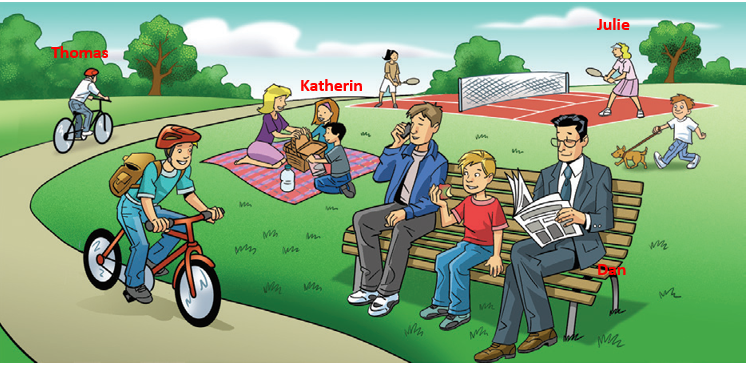Tiếng Anh 7 Unit 2 Language Focus: Present continuous (affirmative and negative)
1. Complete the sentences with the words in the box. Check your answers in the text on page 22. Then choose the correct words in the Rules. 2. Read the Study Strategy. Then write the –ing form of the verbs. Check your answers in the text on page 22. 3. Look at picture A. Complete sentences 1–5 using affirmative and negative forms of the present continuous. : 4. PRONUNCIATION. Sentence stress. 5. USE IT! Look at picture B. Read the sentences from exercise 4. Say if the sentences are True or F
Tổng hợp đề thi học kì 1 lớp 7 tất cả các môn - Chân trời sáng tạo
Toán - Văn - Anh - Khoa học tự nhiên...
Bài 1
1. Complete the sentences with the words in the box. Check your answers in the text on page 22. Then choose the correct words in the Rules.
(Hoàn thành các câu với các từ trong hộp. Kiểm tra câu trả lời của bạn trong văn bản ở trang 22. Sau đó chọn các từ đúng trong Quy tắc.)
|
are becoming aren’t speaking is sending isn’t using |
1. Anna ____________ Lucy an instant message.
2. Anna____________ real words.
3. They ____________ a truly international language.
4. We ____________ face-to-face.
|
RULES 1. We use the present continuous to talk about things happening now / habits. 2. We make the present continuous with the verb do / be and the -ing / base form of a verb. 3. We don’t usually use some verbs in the present continuous. Two of these are be / live and make / have (possession). |
Lời giải chi tiết:
|
1. is sending |
2. isn’t using |
3. are becoming |
4. aren’t speaking |
1. Anna is sending Lucy an instant message.
(Anna đang gửi tin nhắn tức thời cho Lucy.)
2. Anna isn’t using real words.
(Anna không sử dụng từ ngữ thực tế.)
3. They are becoming a truly international language.
(Chúng đang trở thành một ngôn ngữ quốc tế thực sự.)
4. We aren’t speaking face-to-face.
(Chúng tôi không nói chuyện trực tiếp.)
|
RULES (QUY TẮC) 1. We use the present continuous to talk about things happening now. (Chúng ta sử dụng thì hiện tại tiếp diễn để nói về những điều đang xảy ra hiện tại.) 2. We make the present continuous with the verb be and the -ing form of a verb. (Chúng ta chia thì hiện tại tiếp diễn với động từ be và dạng -ing của động từ.) 3. We don’t usually use some verbs in the present continuous. Two of these are live and have (possession). (Chúng ta thường không sử dụng một số động từ ở thì hiện tại tiếp diễn. Hai trong số này là live và have (sở hữu).) |
Bài 2
2. Read the Study Strategy. Then write the –ingform of the verbs. Check your answers in the text on page 22.
(Đọc Chiến thuật học tập. Sau đó viết dạng –ing của các động từ. Kiểm tra câu trả lời của bạn trong phần văn bản ở trang 22.)
|
STUDY STRATEGY (CHIẾN THUẬT HỌC TẬP) |
|
Finding spelling rules (Tìm quy tắc chính tả) Sometimes the final letter of a verb can show you how to spell the continuous form. (Đôi khi chữ cái cuối cùng của động từ có thể chỉ cho bạn cách đánh vần dạng tiếp diễn.) - Look at verbs that end in -e. Do you keep or delete the -e before you add -ing? (Nhìn những động từ kết thúc bằng -e. Bạn giữ hay xóa -e trước khi thêm -ing?) - Look at verbs that end in a short vowel and then a consonant. What letter is added before -ing? (Nhìn những động từ kết thúc bằng một nguyên âm ngắn và sau đó là một phụ âm. Chữ cái nào được thêm vào trước -ing?) |
1. become________
2. use____________
3. send___________
4 speak___________
5. sit_____________
6. write___________
Lời giải chi tiết:
1. becoming (trở nên)
2. using (sử dụng)
3. sending (gửi)
4. speaking (nói)
5. sitting (ngồi)
6. writing (viết)
|
STUDY STRATEGY |
|
Finding spelling rules Sometimes the final letter of a verb can show you how to spell the continuous form. - Look at verbs that end in -e. You delete the -e before you add –ing. (Nhìn vào các động từ kết thúc bằng -e. Bạn xóa -e trước khi thêm –ing.) - Look at verbs that end in a short vowel and then a consonant. That consonant is added before –ing. (Nhìn vào các động từ kết thúc bằng một nguyên âm ngắn và sau đó là một phụ âm. Phụ âm đó được thêm vào trước –ing.) |
Bài 3
3. Look at picture A. Complete sentences 1–5 using affirmative and negative forms of the present continuous.
(Nhìn vào hình A. Hoàn thành các câu 1–5 bằng cách sử dụng các dạng khẳng định và phủ định của thì hiện tại tiếp diễn.)

1. A man, a woman and a dog __________ (sit) in a boat.
2. The man __________ (have) a conversation.
3. The woman __________ (listen).
4. She __________ (sleep).
5. The dog __________ (point) to a sign.
Phương pháp giải:
Thì hiện tại tiếp diễn:
- I am (not) + V-ing
- he / she/ it / chủ ngữ số ít + is (not) + V-ing
- you/ we/ they / chủ ngữ số nhiều + are (not) + V-ing
Lời giải chi tiết:
| 1. are sitting |
1. A man, a woman and a dog are sitting in a boat.
(Một người đàn ông, một phụ nữ và một con chó đang ngồi trên một chiếc thuyền.)
Giải thích: Chủ ngữ số nhiều (a man, a woman, and a dog) + are V-ing => are sitting
2. The man is having a conversation.
(Người đàn ông đang trò chuyện.)
Giải thích: Chủ ngữ số ít (the man) + is V-ing => is having
3. The woman isn't listening.
(Người phụ nữ không đang lắng nghe.)
Giải thích: Chủ ngữ số ít (the woman), câu mang nghĩa phủ định + isn't V-ing => isn't listening
4. She is sleeping.
(Cô ấy đang ngủ.)
Giải thích: She + is V-ing => is sleeping
5. The dog is pointing to a sign.
(Con chó đang chỉ vào một biển báo.)
Giải thích: Chủ ngữ số ít (the dog) + is V-ing => is pointing
Bài 4
4.PRONUNCIATION. Sentence stress
(PHÁT ÂM. Trọng âm của câu)
When we speak, we often put stress oncontent words. Content words carry important information.
LINDA is DANCING.
PETER is READING a STORY.
We don't put stress on structure words.
Structure words make a sentence grammatically correct. For example, am - is - are are structure words in the presentcontinuous tense.
Read and highlight the words we put stresson. Then listen and check.
(Đọc và đánh dấu những từ chúng ta nhấn mạnh. Sau đó, lắng nghe và kiểm tra.)
1. They aren’t having a fantastic holiday!
2. The man is helping the dog.
3. The dog is swimming.
4. The woman isn’t sleeping.
5. The man is speaking on the phone.
Phương pháp giải:
Tạm dịch:
Khi nói, chúng ta thường đặt trọng âm vào các từ thuộc về mặt nội dung. Các từ thuộc về mặt nội dung mang thông tin quan trọng.
LINDA đang NHẢY.
PETER ĐANG ĐỌC một CÂU CHUYỆN.
Chúng ta không đặt trọng tâm vào các từ thuộc về mặt cấu trúc.
Các từ thuộc về mặt cấu trúc tạo nên một câu đúng ngữ pháp. Ví dụ, am - is - are là những từ thuộc về mặt cấu trúc ở thì hiện tại tiếp diễn.
Lời giải chi tiết:
1. THEY AREN’T HAVING a FANTASTIC HOLIDAY!
(Họ không có một kỳ nghỉ tuyệt vời!)
2. The MAN is HELPING the DOG.
(Người đàn ông đang giúp con chó.)
3. The DOG is SWIMMING.
(Con chó đang bơi.)
4. The WOMAN ISN’T SLEEPING.
(Người phụ nữ đang không ngủ.)
5. The MAN is SPEAKING on the PHONE.
(Người đàn ông đang nói chuyện điện thoại.)
Bài 5
5. USE IT! Look at picture B. Readthe sentences from exercise 4. Say if thesentences are True or False.
(THỰC HÀNH! Nhìn vào bức tranh B. Đọc các câu trong bài tập 4. Cho biết câu đó là Đúng hay Sai.)

Lời giải chi tiết:
| 1. T | 2. F | 3. F | 4. T | 5. T |
1. T
They aren’t having a fantastic holiday!
(Họ không có một kỳ nghỉ tuyệt vời!)
2. F
The man is helping the dog.
(Người đàn ông đang giúp con chó.)
=> The man is speaking on the phone.
(Người đàn ông đang nói chuyện điện thoại.)
3. F
The dog is swimming.
(Con chó đang bơi.)
=> The dog is sitting on a plank.
(Con chó đang ngồi trên một tấm ván.)
4. T
The woman isn’t sleeping.
(Người phụ nữ không ngủ.)
5. T
The man is speaking on the phone.
(Người đàn ông đang nói chuyện điện thoại.)
Finished?
Finished? Find another picture in this book and describe it to your partner.
(Bạn đã hoàn thành? Tìm một bức tranh khác trong cuốn sách này và mô tả nó cho bạn của bạn.)

Lời giải chi tiết:
1. Dan is reading a newspaper.
(Dan đang đọc báo.)
2. Katherine is helping her mom.
(Katherine đang giúp mẹ cô ấy.)
3. Thomas is riding a bike.
(Thomas đang đi xe đạp.)
4. Julie is playing tennis with her friend.
(Julie đang chơi tennis với bạn của cô ấy.)
- Tiếng Anh 7 Unit 2 Vocabulary and Listening
- Tiếng Anh 7 Unit 2 Language Focus: Present continuous - questions
- Tiếng Anh lớp 7 Unit 2 Speaking: Making plans over the phone
- Tiếng Anh 7 Unit 2 Writing: A report on a survey
- Tiếng Anh 7 Unit 2 Culture: English is all around
>> Xem thêm
Luyện Bài Tập Trắc nghiệm Tiếng Anh 7 - Friends Plus - Xem ngay












